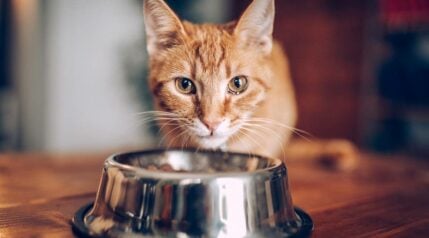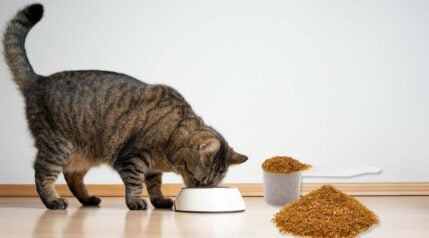When you purchase through links on our site, we may earn a commission. Here’s how it works.
It’s an iconic image: a contented cat lapping up a saucer of milk. Most cats enjoy the taste of dairy products, but does that mean it’s okay for them to eat? What about ice cream for cats?
We love the idea of sharing our favorite treats with our fur babies, but not all snacks are meant to be shared. Can cats eat ice cream or should this treat be avoided? Get the scoop on cat-safe ice cream and ice cream recipes for cats.
Can Cats Eat Ice Cream?
According to the American Society for the Prevention of Cruelty to Animals (ASCPA), most adult cats are lactose intolerant. While kittens produce enough lactase enzymes to break down mom’s milk, most cats stop producing lactase after their first year. Because the lactose isn’t broken down quickly and digested, it ferments and causes gastrointestinal issues. Symptoms of lactose intolerance include:
- Abdominal Pain: Abdominal pain results from excess gastrointestinal and abdomen gas. If your feline limits their movements after eating dairy, it indicates they may be experiencing abdominal pain.
- Bloating and Gas: Gas and fluid retention occurs when your cat cannot break down the lactose in dairy.
- Constipation: Your cat may experience constipation if their gastrointestinal tract struggles to move food and liquids through the intestines.
- Dehydration: Vomiting and diarrhea can lead to dehydration. Dehydration can cause thirst, dry mouth, dizziness, muscle cramping, fast heart rate, and more. Severe cases of dehydration can lead to kidney damage, brain damage, and death.
- Diarrhea: Runny or watery stools can cause dehydration, electrolyte imbalance, and kidney failure.
- Increased Thirst: Vomiting and diarrhea can cause increased thirst.
- Vomiting: Vomiting is the body’s way of eliminating harmful substances.
A 2019 study published in Biosciences Biotechnology Research Asia showed that cats regularly ingesting cow’s milk had increased visits to the vet for gastrointestinal-related issues. Researchers then placed these same cats on a lactose-free diet. They began showing improvements after three weeks and were entirely healthy after six weeks.
What about lactose-free or non-dairy ice cream? Are these cate-safe ice creams? Aside from dairy, ice cream is also high in sugar and fat, which can lead to other issues:
- Arthritis
- Weight Gain
- Obesity
- Diabetes
Can cats eat ice cream? Really, they shouldn’t. This food offers no nutritional and can cause health issues that can be detrimental to your feline’s overall well-being. If you decide to give your cat a lick of your ice cream, always confirm that it’s free of toxic ingredients. Chocolate and the sweetener xylitol are toxic to felines and should never be fed to cats.
Cat-Safe Ice Cream
If it makes you sad to think that your cat can’t enjoy this delicious summertime staple, you’ll be delighted to know that cat ice cream actually exists. Pet Winery developed the first-ever cat-friendly ice cream.
Pet Creamery

- Ingredients: dehydrated goat milk, dried bonito flakes
- 32% crude protein, 14% crude fat, 5% crude fiber, 10% moisture
- Makes 1/2 pint ice cream for cats
- Kitty Sprinkles Ice Cream Topper made from organic catnip and silvervine (sold separately)
Pet Winery’s Screaming Bonito cat ice cream is a simple recipe made with two ingredients: dehydrated goat milk and dried bonito fish flakes. Instructions say to mix the powder blend with hot water and stir before freezing for eight hours. From there, serve your cat this frozen treat.
Pet Winery uses dehydrated goat’s milk as an alternative to cow’s milk. While goat milk still has significant amounts of lactose, it has less than cow’s milk. Cats may be able to eat goat’s milk without any digestive upset; however, this ice cream may still be a no-no if your cat has significant lactose intolerance.
This ice cream also contains calcium, phosphorus, zinc, selenium, and vitamin E. It’s a source of anti-inflammatory ingredients glucosamine and chondroitin sulfate, which help support your cat’s joints. At 390 calories per cup, this is a high-calorie treat that should be fed in moderation.
Churu Pops

- Freezable, treat with chewy outer layer and lickable center
- 7% crude protein, .20% crude fat, .30% crude fiber, 91% moisture
- Free of grains, soy, preservatives, and artificial colors
- Contains green tea for antioxidant support
For the felines that prefer popsicles to ice cream: Inaba’s Churu Pops. Inaba markets these chewy purees as a freezable summertime treat for your cat. Churu Pops are available in three recipes: chicken, tuna, or tuna with chicken. Let’s look at the chicken recipe:
Ingredients: Water, Chicken, Natural Flavors, Natural Scallop Flavor, Carrageenan, Xanthan Gum, Guar Gum, Potassium Chloride, Vitamin E Supplement, Sodium Citrate, Green Tea Extract.
Inaba adds seaweed-derived carrageenan in combination with potassium chloride as a thickener, stabilizer, gelling agent, and protein-suspending agent. We know that carrageenan caused gastrointestinal disease in laboratory animals (guinea pigs, rats, monkeys, mice, rabbits, and ferrets). Experiments showed that exposure to carrageenan was associated with a higher occurrence of intestinal lesions, inflammation, and colon cancer.
Inaba also uses xantham gum and guar gum as thickeners, both of which may cause diarrhea for those cats with sensitive stomachs. We would prefer to see gelatin in this formula, as it’s made from animal parts (remember, cats are carnivores), it’s a thickening and gelling agent, and it has many additional benefits for pets, including support for joints, skin, and teeth. Skip these recipes if you’re worried about these thickeners. Instead, try making a DIY popsicle at home.
Ice Cream Recipes For Cats
You can make a quick and easy DIY ice cream treat for your furry friend using wet food, bone broth, or goat milk (or a combination of all three!) All you need is a silicone ice cube tray and your ingredients of choice. Just pour the blend into an ice cube tray and freeze. Add extra water to your recipe for additional hydration during those hot summer months.
Ready for some intermediate recipes? We’ve scoured the internet for some of our favorite recipes:
- Hattie’s Blog makes ice cream using CatSip milk, pate-style cat food, and salt.
- KittyCatGo has a variety of frozen treat recipes, including a homemade Churu treat recipe.
- The Canadian pet store Homes Alive Pets shares a DIY popsicle recipe on its blog.
Frequently Asked Questions
Do Cats Like Ice Cream?
Felines lack the taste receptors to recognize sweetness; however, your cat might like ice cream thanks to its smooth texture and tasty fat content. Your cat may love ice cream or turn up their nose at this chilled dessert. Regardless, ice cream isn’t healthy for cats. We don’t recommend cats eat ice cream for the same reason that we don’t recommend humans eat ice cream for every meal: this high-calorie dessert is filled with fat and added sugar. To avoid begging every time you get out the ice cream carton, avoid feeding your cat ice cream in the first place.
Can Kittens Eat Ice Cream?
No, kittens shouldn’t eat ice cream. While kittens may be able to digest lactose better than adult cats, ice cream is high in sugar and fat, making it an unhealthy treat for a growing body. Kittens have specific requirements for development and growth. Feeding your cat unnecessary foods like ice cream too early could cause future digestive problems.
Final Thoughts
As with all things that are bad for us and our pets, the key is moderation. If you give your cat a single lick of ice cream, chances are you won’t notice any adverse effects. If you let your cat chow down on a whole pint of ice cream, they’re sure to have a tummy ache and constant trips to the litter box. Consult your veterinarian for advice on feeding your cat. You can also read our guide on what human foods cats can eat.





